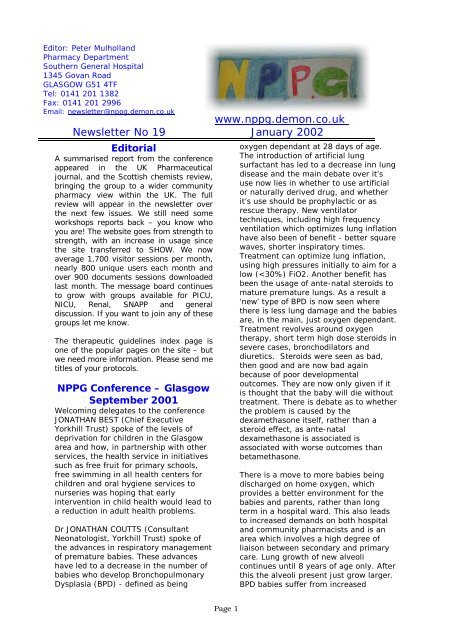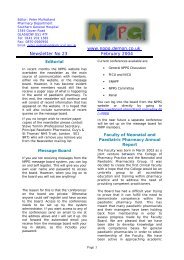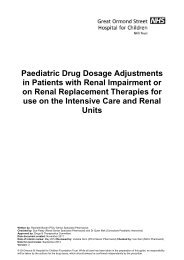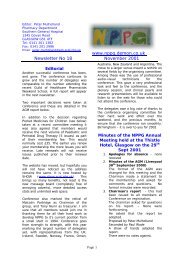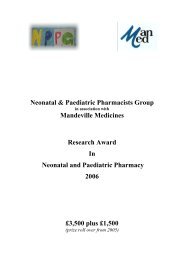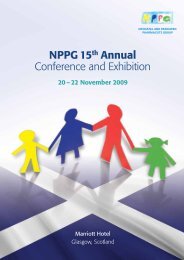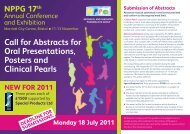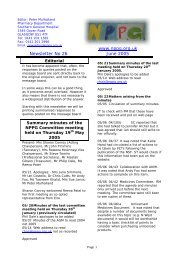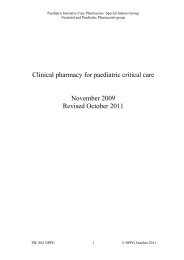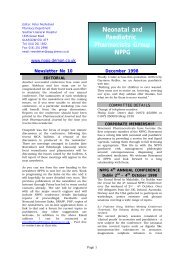NPPG Newsletter 19 - Neonatal and Paediatric Pharmacists Group
NPPG Newsletter 19 - Neonatal and Paediatric Pharmacists Group
NPPG Newsletter 19 - Neonatal and Paediatric Pharmacists Group
You also want an ePaper? Increase the reach of your titles
YUMPU automatically turns print PDFs into web optimized ePapers that Google loves.
Editor: Peter Mulholl<strong>and</strong><br />
Pharmacy Department<br />
Southern General Hospital<br />
1345 Govan Road<br />
GLASGOW G51 4TF<br />
Tel: 0141 201 1382<br />
Fax: 0141 201 2996<br />
Email: newsletter@nppg.demon.co.uk<br />
www.nppg.demon.co.uk<br />
<strong>Newsletter</strong> No <strong>19</strong> January 2002<br />
Editorial<br />
A summarised report from the conference<br />
appeared in the UK Pharmaceutical<br />
journal, <strong>and</strong> the Scottish chemists review,<br />
bringing the group to a wider community<br />
pharmacy view within the UK. The full<br />
review will appear in the newsletter over<br />
the next few issues. We still need some<br />
workshops reports back – you know who<br />
you are! The website goes from strength to<br />
strength, with an increase in usage since<br />
the site transferred to SHOW. We now<br />
average 1,700 visitor sessions per month,<br />
nearly 800 unique users each month <strong>and</strong><br />
over 900 documents sessions downloaded<br />
last month. The message board continues<br />
to grow with groups available for PICU,<br />
NICU, Renal, SNAPP <strong>and</strong> general<br />
discussion. If you want to join any of these<br />
groups let me know.<br />
The therapeutic guidelines index page is<br />
one of the popular pages on the site – but<br />
we need more information. Please send me<br />
titles of your protocols.<br />
<strong>NPPG</strong> Conference – Glasgow<br />
September 2001<br />
Welcoming delegates to the conference<br />
JONATHAN BEST (Chief Executive<br />
Yorkhill Trust) spoke of the levels of<br />
deprivation for children in the Glasgow<br />
area <strong>and</strong> how, in partnership with other<br />
services, the health service in initiatives<br />
such as free fruit for primary schools,<br />
free swimming in all health centers for<br />
children <strong>and</strong> oral hygiene services to<br />
nurseries was hoping that early<br />
intervention in child health would lead to<br />
a reduction in adult health problems.<br />
Dr JONATHAN COUTTS (Consultant<br />
Neonatologist, Yorkhill Trust) spoke of<br />
the advances in respiratory management<br />
of premature babies. These advances<br />
have led to a decrease in the number of<br />
babies who develop Bronchopulmonary<br />
Dysplasia (BPD) - defined as being<br />
oxygen dependant at 28 days of age.<br />
The introduction of artificial lung<br />
surfactant has led to a decrease inn lung<br />
disease <strong>and</strong> the main debate over it’s<br />
use now lies in whether to use artificial<br />
or naturally derived drug, <strong>and</strong> whether<br />
it’s use should be prophylactic or as<br />
rescue therapy. New ventilator<br />
techniques, including high frequency<br />
ventilation which optimizes lung inflation<br />
have also been of benefit - better square<br />
waves, shorter inspiratory times.<br />
Treatment can optimize lung inflation,<br />
using high pressures initially to aim for a<br />
low (
chestiness <strong>and</strong> have subtle differences in<br />
exercise intolerance in adulthood.<br />
Premature babies have a high pulmonary<br />
vascular resistance <strong>and</strong> a potential result<br />
of this is the development of Persistent<br />
Pulmonary Hypertension of the Newborn<br />
(PPHN). This is a cardiopulmonary<br />
disorder characterized by systemic<br />
arterial hypoxemia secondary to<br />
elevated pulmonary vascular resistance<br />
with resultant shunting of pulmonary<br />
blood flow to the systemic circulation.<br />
Systemic vasodilators have side effects<br />
<strong>and</strong> are not recommended. The<br />
treatment of choice is inhaled nitric<br />
oxide, which is a natural vasodilator <strong>and</strong><br />
only enters the ventilated alveoli. It is<br />
inactivated by haemoglobin once it<br />
enters the bloodstream. It is easy to give<br />
via a ventilator <strong>and</strong> a portable system is<br />
available for transfer of patients between<br />
hospitals. Extracorporeal membrane<br />
oxygenation (ECMO) is used as rescue<br />
therapy in cases of severe respiratory<br />
failure <strong>and</strong> is currently available in 4<br />
centres in the UK.<br />
complications associated with ECMO<br />
include:<br />
• haemhorrage (due to the need to<br />
heparinise the blood flowing<br />
through the circuit)<br />
• circuit problems<br />
• loss of the carotid artery<br />
long term developmental studies are<br />
awaited<br />
drug therapy tends towards st<strong>and</strong>ard<br />
doses <strong>and</strong> monitor where possible. If<br />
ECMO is not working an alternative is<br />
liquid ventilation using perfluorocarbons.<br />
RSV (Respiratory Syncytial Virus) is a<br />
common cause of bronchiolytis in babies<br />
<strong>and</strong> young children. Healthy infants do<br />
well (mortality < 1%) but high risk<br />
infants can have a mortality up to 30%,<br />
or can suffer long term respiratory<br />
problems. Recently Palivizumab ( a<br />
humanized murine RSV IgG monoclonal<br />
antibody) has been launched for passive<br />
vaccination against this illness.. Studies<br />
have shown it to decrease hospitalisation<br />
<strong>and</strong> ICU admissions, but treatment cost<br />
is expensive at around £3,000 per<br />
patient. In Greater Glasgow strict<br />
adherence to the SPC guidance could<br />
have resulted in an annual cost of over<br />
£2 million. Following a review by<br />
paediatricians <strong>and</strong> pharmacists<br />
treatment criteria were agreed to target<br />
the most vulnerable patients <strong>and</strong> this<br />
was funded by the Health Board. In<br />
addition to vaccination , in the<br />
community parents have to be educated<br />
to the risk of RSV, including the<br />
prevention of cross infection. The role of<br />
ribavirin was queried as to its<br />
effectiveness.<br />
Speaking on the topic of ‘<strong>Neonatal</strong><br />
Surgery - size does matter' CARL DAVIS<br />
(Consultant <strong>Neonatal</strong> Surgeon, Yorkhill<br />
Trust) covered the range of neonatal<br />
conditions treated surgically at Yorkhill<br />
including congenital anomalies (often<br />
multiple) <strong>and</strong> prematurity associated<br />
conditions such as Necrotising<br />
Enterocolitis (NEC). As with respiratory<br />
problems there is a changing pattern if<br />
the diseases to be treated. The<br />
prevalence of neural tube defects<br />
continues to fall, even with the lack of<br />
publicity on the use of folic acid in<br />
women’s press. Many other defects are<br />
picked up ante-natally.<br />
With respect to pain control the use of<br />
epidural analgesia has greatly benefited<br />
neonatal surgery, with resultant<br />
decrease in the need for post operative<br />
ventilation. There still remains, however,<br />
the need to find a suitable agent to<br />
bridge the gap between paracetamol <strong>and</strong><br />
morphine.<br />
<strong>Neonatal</strong> surgery requires a multidisciplinary<br />
team <strong>and</strong> an example of this<br />
is in the treatment of short bowel<br />
disease. Here the aim is to get patients<br />
home, possibly on home TPN. The<br />
pharmacy aseptic unit at Yorkhill<br />
provides, on average, 400TPN days to<br />
the neonatal surgery unit per month.<br />
Enteral feeding is used where possible<br />
<strong>and</strong>, as with healthy babies, ‘breast is<br />
best’.<br />
Congenital diaphragmatic hernia is a<br />
long term in-utero problem which can<br />
result in complications, even after<br />
surgery. An option is the use of in-utero<br />
surgery, but this is still a very emotive<br />
area.. Treatment strategies include<br />
ECMO, but this does not treat the<br />
Page 2
smaller lung, only resting the respiratory<br />
circulation. A possible treatment option<br />
is the use of liquid ventilation with<br />
perfluorocarbons. There have been no<br />
trails to date, only anecdotal data <strong>and</strong><br />
small series reports.<br />
At the AGM of the <strong>NPPG</strong> the decision was<br />
taken that the group would support the<br />
formation of a faculty of <strong>Neonatal</strong> <strong>and</strong><br />
<strong>Paediatric</strong> Pharmacy by the College of<br />
Pharmacy Practice. It is expected that<br />
the faculty will be formed later this year.<br />
The motion was also passed, with just<br />
one vote against, that <strong>NPPG</strong> become a<br />
'company limited by guarantee' with<br />
each member's liability being £1.<br />
Four members of the committee stood<br />
down - Malcolm Partridge, Tony Nunn,<br />
Anne Frankish <strong>and</strong> Vicky Bradnam.<br />
There were 4 nominations for election,<br />
so no election was necessary. At a<br />
subsequent committee meeting over<br />
lunchtime the roles of new chairman <strong>and</strong><br />
treasurer were decided. Details of the<br />
new committee can be found on the<br />
committee pages<br />
At the close of conference James Wallace<br />
praised the contributions of both<br />
Malcolm Partridge <strong>and</strong> Tony Nunn to<br />
<strong>NPPG</strong>. Both had been involved in the<br />
foundation of the group <strong>and</strong> had made<br />
major contributions to the group over<br />
the past 7 years.<br />
Clinical Pearls/Research<br />
The use of sodium benzoate in<br />
asparaginase’s overdose<br />
S. Roy 1 , A. Doloy 1 , S. Djoussa-Kambou 1 ,<br />
F. Legr<strong>and</strong> 2 , F. Brion 1 , A. Rieutord 1<br />
1Service de pharmacie-toxicologie,<br />
²service d’hématologie, Hôpital Robert<br />
Debré AP-HP, Paris, France<br />
Introduction : L-asparaginase is an<br />
enzyme that catalyses the hydrolysis of<br />
L-asparagine to L-aspartate <strong>and</strong><br />
ammonium. L-asparagine is an essential<br />
amino-acid for the multiplication of<br />
leukemia cells. This enzyme is<br />
prescribed with other cytotoxic drugs, to<br />
treat acute lymphoblastic leukaemia<br />
(ALL) <strong>and</strong> non-Hodgkin lymphomas. We<br />
report herein the case of an<br />
asparaginase’s overdose, treated with<br />
sodium benzoate.<br />
Case report : D.T. (three-year-old, 0,66<br />
m) suffering from ALL, received a<br />
st<strong>and</strong>ardised chemotherapy protocol<br />
EORTC (dexamethasone 3 mg/m²,<br />
vincristine 1,5 mg/m², daunorubicine 30<br />
mg/m², asparaginase E. Coli 10000<br />
UI/m², intrathecal injections of<br />
methotrexate, cytarabine <strong>and</strong><br />
hydrocortisone).<br />
On the day 15 of the protocol, a dose of<br />
aspariginase E. Coli, ten times higher<br />
than the prescribed one’s, was<br />
administered. The clinical examination<br />
was normal although biological<br />
parameters showed an increase of some<br />
amino-acids (glutamic <strong>and</strong> asparticacids)<br />
<strong>and</strong> ammonium : 224 µmol/L<br />
(usual value : 14-38 µmol/L).<br />
A sodium benzoate-based treatment, i.e.<br />
206 mg/kg/day, was started <strong>and</strong> lasted<br />
for three days.<br />
Discussion : The main side effect of<br />
asparaginase is the neurotoxicity due to<br />
the depletion of asparagine, required for<br />
cerebral formation, <strong>and</strong> the increase of<br />
ammonium level. Sodium benzoate,<br />
associated with glycine, has been used<br />
as an alternative way to favor the<br />
nitrogen excretion, as hippuric acid.<br />
The day after the overdose, ammonium<br />
level was highest, i.e. 3<strong>19</strong> µmol/L, then<br />
decreasing quite rapidly. The child<br />
presented no serious adverse effect <strong>and</strong><br />
kept receiving his chemotherapy<br />
treatment three days after overdose.<br />
Conclusion : No such overdose was<br />
found in the literature except the case of<br />
a four year old-boy who had received<br />
4200 UI [1]. The treatment<br />
recommended could be sodium benzoate<br />
250 UI/kg/day but evidence for treating<br />
patient after asparaginase’s overdose<br />
still needs to be demonstrated. The<br />
duration of treatment is unknown but it<br />
could be established with respect to<br />
ammonium level. Measurements of<br />
ammonium, urea <strong>and</strong> amino-acids are<br />
the key points of the monitoring.<br />
[1] Leonard JV, Kay JD : Acute<br />
encephalopathy <strong>and</strong> hyperammonemia<br />
complicating treatment of acute<br />
lymphoblastic leukaemia with<br />
Page 3
asparaginase (letter). Lancet <strong>19</strong>86 ; 1 :<br />
162-3.<br />
Practical use of area under the curve<br />
dosing of vancomycin in endocarditis<br />
(Naomi Warner, Alder Hey Children’s<br />
Hospital)<br />
AB was a 15-year-old female cardiac<br />
patient who was admitted in April 2001<br />
with increased temperature <strong>and</strong> rigors<br />
having been generally unwell for six<br />
weeks. Her previous medical history<br />
included transposition of the great<br />
arteries (TGA), ventricular septal defect<br />
(VSD), pulmonary atresia, <strong>and</strong> right<br />
ventricular outflow tract obstruction<br />
(RVOTO). She had had a severe<br />
postoperative sternal wound infection<br />
<strong>and</strong> had been diagnosed with subacute<br />
bacterial endocarditis (SBE) in 2000.<br />
The impression made by the medical<br />
team was that of endocarditis <strong>and</strong> she<br />
was started on IV vancomycin bd <strong>and</strong><br />
teicoplanin loading then maintenance.<br />
Following a ‘red man reaction’ to the<br />
vancomycin her antibiotics were<br />
subsequently changed to netilmicin tds<br />
<strong>and</strong> teicoplanin.<br />
Blood cultures showed growth of a<br />
coagulase negative staphylococci, Staph<br />
epidermidis, which was sensitive to<br />
netilmicin <strong>and</strong> vancomycin. After<br />
discussion with microbiology <strong>and</strong> the<br />
cardiology team it was decided to restart<br />
vancomycin extending the infusion time<br />
from one hour to six hours <strong>and</strong> giving<br />
chlorpheniramine IV pre dose.<br />
Vancomycin was then changed to tds<br />
dosing on the advice of the<br />
microbiologist. On further investigation<br />
this dosing schedule was based on a<br />
paper written by Schentag JJ (1) which<br />
discussed the reasons for insufficient<br />
responses <strong>and</strong> the resistance of<br />
organisms to vancomycin. This paper<br />
investigated area under the inhibitory<br />
curve (AUIC) dosing where the goal of<br />
therapy is to cover the minimum<br />
inhibitory curve (MIC) of the grampositive<br />
pathogen, failure to cure <strong>and</strong><br />
resistance are consequences of failing to<br />
cover the MIC. It stated that the usual<br />
breakpoint for successful bacterial<br />
eradication is an AUIC of >125.<br />
In order to determine the AUIC for this<br />
patient we needed to determine the MIC<br />
for the organism we had, await steady<br />
state <strong>and</strong> then take a peak sample (1hr<br />
after the end of the infusion), <strong>and</strong> a<br />
trough sample. Using the trapezoid rule<br />
for area under the curve measurement<br />
the AUIC could be calculated <strong>and</strong> the<br />
dosing altered appropriately to maintain<br />
therapeutic levels <strong>and</strong> ensure<br />
eradication. All calculations were carried<br />
out by pharmacy taking into account any<br />
changes in renal function <strong>and</strong> CRP. IV<br />
antibiotic treatment was continued for<br />
six weeks, after which time blood<br />
cultures were clear <strong>and</strong> AB was<br />
discharged, returning twice weekly for<br />
blood cultures <strong>and</strong> U&E’s.<br />
REFERENCES<br />
1) Schentag JJ 2001 Antimicrobial<br />
management strategies for Grampositive<br />
bacterial resistance in the<br />
intensive care unit. Critical Care<br />
Medicine Vol 29, No 4; 100-107<br />
A scheme for the reporting of<br />
adverse drug reactions in children A<br />
Clarkson, I Choonara, Academic Division<br />
of Child Health (University of<br />
Nottingham), Derbyshire Children's<br />
Hospital, Uttoxeter Road, Derby, DE22<br />
3NE, UK<br />
BACKGROUND- The safety of medicines<br />
used in children is of considerable public<br />
interest, yet available data to monitor<br />
the safety of medicines in children is<br />
limited.<br />
AIMS- To raise awareness <strong>and</strong> stimulate<br />
reporting of adverse drug reactions<br />
(ADRs) in children in the Trent region.<br />
METHODS- A pilot <strong>Paediatric</strong> Regional<br />
Monitoring Centre (PRMC) was<br />
established in October <strong>19</strong>98 in the Trent<br />
region. The scheme operates as an<br />
extension of the UK's spontaneous<br />
reporting scheme, The Yellow Card<br />
Scheme run by the Medicines Control<br />
Agency (MCA) <strong>and</strong> the Committee on<br />
Safety of Medicines. Proactive<br />
interventions including a monthly<br />
reminder letter <strong>and</strong> presentations to<br />
staff in the identified hospital have been<br />
made.<br />
RESULTS- There were 442 reports at the<br />
end of the third year which included 9<br />
fatalities. This is an increase compared<br />
to the 40 reports for the year <strong>19</strong>97/98.<br />
66% of the reports were serious The<br />
most commonly suspected medicine was<br />
lamotrigine <strong>and</strong> the most commonly<br />
Page 4
suspected reaction was rash. A wide<br />
range of medicines are suspected of<br />
causing a wide range of reactions. 60%<br />
of the medicines suspected were being<br />
used in a licensed manner.<br />
CONCLUSION- The number of ADR<br />
reports from the Trent region has<br />
increased considerably since the scheme<br />
started. The results so far show that<br />
intensive education <strong>and</strong> promotion of<br />
ADR reporting can result in a major<br />
increase in reporting.<br />
INTRATHECAL DRUG DELIVERY IN<br />
CHILDREN WITH BRAIN TUMOURS S<br />
Conroy 1 , D Walker 2 1 Academic Division of<br />
Child Health, (University of Nottingham),<br />
Derbyshire Children's Hospital, Derby<br />
2 Academic Division of Child Health,<br />
University of Nottingham, Queen's<br />
Medical Centre, Nottingham<br />
Background<br />
Intrathecal drug therapy has been shown<br />
to be successful in treating the<br />
leptomeningeal spread of malignancies<br />
such as leukaemia <strong>and</strong> lymphoma. It<br />
has rarely been explored as a treatment<br />
for primary CNS tumours. Treatment is<br />
currently surgical resection <strong>and</strong><br />
radiation. Radiation causes neurocognitive<br />
sequelae affecting the quality<br />
of life of survivors. Alternative means of<br />
treating these patients to improve<br />
survival rates <strong>and</strong> reduce toxicity is<br />
urgently needed. Intrathecal drug<br />
delivery may offer this alternative by<br />
bypassing the blood brain barrier <strong>and</strong><br />
allowing cytotoxic drugs access to<br />
tumour cells. The aim of this project<br />
was to identify drugs suitable for further<br />
investigation for intrathecal<br />
administration based on their<br />
physicochemical characteristics <strong>and</strong><br />
current knowledge of use.<br />
Methods<br />
Available chemotherapy agents were<br />
identified from pharmaceutical<br />
textbooks. Literature searches using<br />
Medline <strong>and</strong> Embase were conducted to<br />
identify relevant physicochemical,<br />
efficacy <strong>and</strong> toxicity data on all drugs.<br />
Results<br />
30,033 citations were screened covering<br />
111 cytotoxic drugs. 90 drugs were<br />
excluded for a variety of reasons. These<br />
included literature evidence of<br />
neurotoxicity, irritant or vesicant drug,<br />
lack of efficacy in the appropriate<br />
tumours, pro-drug requiring hepatic<br />
activation. The remainder were<br />
prioritised in terms of their potential<br />
usefulness for intrathecal administration,<br />
based on efficacy <strong>and</strong> toxicity<br />
information, documented experience of<br />
intrathecal delivery <strong>and</strong> relevant<br />
physicochemical characteristics.<br />
Conclusion<br />
Drugs showing potential for<br />
administration by the intrathecal route in<br />
children with brain tumours were<br />
identified. Further work should<br />
determine which drugs will be worthy of<br />
testing in clinical trials.<br />
The potential for administering a ten<br />
fold overdose to neonates - a<br />
summary (K Turner, C Newman)<br />
Introduction<br />
The potential for medication errors in the<br />
area of neonatal medicine is of great<br />
concern. There have been several<br />
reports of fatal errors, particularly due to<br />
ten, one hundred or even one<br />
thous<strong>and</strong>fold errors, i.e. decimal point<br />
errors, in prescribing, preparation or<br />
administration. This problem is<br />
exacerbated by the high strength of<br />
intravenous vials, which are often<br />
tailored to the needs of adults. The aim<br />
of the study was to determine the<br />
proportion of prescribed doses where the<br />
potential existed to prepare a tenfold or<br />
one hundredfold overdose from the vial<br />
strength available on the ward.<br />
Method<br />
Over a period of 6 weeks between<br />
January <strong>and</strong> February 2001, all IV drugs<br />
prescribed on the neonatal unit at QMC<br />
were recorded. Information collected<br />
included patient details, drug, dose,<br />
number of doses given, whether the<br />
prescription was for an infusion or a<br />
bolus <strong>and</strong> time of prescribing. The doses<br />
prescribed were compared to the<br />
strength of vial available on the ward for<br />
each drug.<br />
Results<br />
A total of 336 IV prescriptions were<br />
recorded <strong>and</strong> 1348 IV doses were given.<br />
Of these, 104 (31%) of the prescriptions<br />
Page 5
were less than or equal to one tenth of a<br />
vial. This equated to 333 IV doses (25%<br />
of doses administered). Also, 16 (4.8%)<br />
of prescriptions were less then one<br />
hundredth of a vial, equating to 32 IV<br />
doses (2.4% of doses administered).<br />
Drugs highlighted as having a high<br />
proportion of doses in the above<br />
categories were indomethacin, insulin,<br />
diamorphine <strong>and</strong> frusemide. It is<br />
concerning that these are some of the<br />
most harmful drugs in overdose.<br />
Discussion<br />
Many factors have been shown to affect<br />
the incidence of administration errors.<br />
These include nursing shortages <strong>and</strong><br />
high rates of interruption during<br />
checking <strong>and</strong> administration of drugs. As<br />
these situations occur on every unit,<br />
safeguards must be put in place to<br />
reduce the possibility of an error. The<br />
results highlight the benefits of providing<br />
a CIVAS service <strong>and</strong> indicate the areas of<br />
highest risk <strong>and</strong> therefore most benefit.<br />
However, the manufacture of lower<br />
strength vials would make preparation<br />
on the unit safer.<br />
Conclusion<br />
The potential for this type of error will<br />
remain as long as vials are<br />
manufactured with a view to treating<br />
adults. The way forward may be the<br />
formation of a <strong>Neonatal</strong> Unit consortium<br />
that would increase purchasing power.<br />
The national dem<strong>and</strong> for smaller sized<br />
vials or pressure from the licensing<br />
authorities may result in manufacture of<br />
neonatal targeted products.<br />
<strong>Paediatric</strong> Medicines <strong>and</strong> the<br />
UK Parliament<br />
On 16 th October 2001 Dr Evan Harris<br />
(Oxford West <strong>and</strong> Abingdon) asked the<br />
Secretary of State for Health<br />
(1) what recent assessment he has<br />
made of drugs being used for the<br />
treatment of children which are<br />
not licensed for that purpose;<br />
(2) what assessment he has made of<br />
the need for research to establish<br />
the safety <strong>and</strong> efficacy of all<br />
drugs used in the treatment of<br />
children;<br />
(3) what estimate he has made of<br />
the number of children who (a)<br />
died <strong>and</strong> (b) were injured as a<br />
result of treatment with drugs not<br />
licensed for the treatment of<br />
children in each of the last five<br />
years; <strong>and</strong> if he will make a<br />
statement;<br />
(4) what steps he is taking to ensure<br />
that pharmaceutical companies in<br />
the United Kingdom provide clear<br />
dosage information for children<br />
<strong>and</strong> adults on all drugs they<br />
produce; <strong>and</strong> if he will make a<br />
statement<br />
(5) what percentage of medicines<br />
used for treatment of children do<br />
not have a dosage approved by<br />
the Medicines Control Agency;<br />
<strong>and</strong> if he will make a statement.<br />
In response Ms Hazel Blears<br />
(Parliamentary Under-Secretary of State<br />
for Health) replied:<br />
‘We recognise the critical importance of<br />
this issue <strong>and</strong> agree that children should<br />
have access to medicines that have been<br />
fully evaluated to the same high<br />
st<strong>and</strong>ards of safety, quality <strong>and</strong> efficacy<br />
as those available for the adult<br />
population. The issue is not confined to<br />
the United Kingdom, but affects the<br />
whole of Europe <strong>and</strong> the United States.<br />
Medicines regulation in the UK derives<br />
largely from European legislation <strong>and</strong> an<br />
international approach to the issue is<br />
therefore needed.<br />
We have consequently raised the profile<br />
of this issue at a European level,<br />
including taking the lead in developing a<br />
European guideline, adopted in <strong>19</strong>97, to<br />
encourage companies to undertake<br />
appropriate clinical trials on the use of<br />
medicines in the treatment of children.<br />
This formed the basis for an<br />
international guideline, which came into<br />
operation in January in the EU, <strong>and</strong> also<br />
applies in the USA <strong>and</strong> Japan. In<br />
addition, the Council of the European<br />
Union has asked the European<br />
Commission to bring forward measures<br />
to make sure that medicines for children<br />
are fully adapted to their specific needs.<br />
We are presently waiting for their<br />
proposals. However, the Commission has<br />
stated its intention to comply with this<br />
request. The UK will play an active role<br />
in the development of this initiative to<br />
ensure that effective solutions are found.<br />
In addition, the Committee on<br />
Proprietary Medicinal Products (CPMP),<br />
Page 6
the scientific advisory committee of the<br />
European Medicines Evaluation Agency<br />
(EMEA), recognising the importance of<br />
this topic has announced its intention to<br />
set up a <strong>Paediatric</strong> Expert <strong>Group</strong> to<br />
advise the EMEA <strong>and</strong> its scientific<br />
committees on all questions relating to<br />
the development <strong>and</strong> use of medicinal<br />
products in children. The UK has<br />
nominated representatives to this<br />
<strong>Paediatric</strong> Expert <strong>Group</strong>.<br />
In the meantime, the UK Government<br />
have taken important steps to address<br />
the issue at a national level within the<br />
existing regulatory framework. The<br />
Committee on Safety of Medicines<br />
(CSM), an independent expert<br />
committee that advises the Licensing<br />
Authority has established a <strong>Paediatric</strong><br />
Sub-<strong>Group</strong> to provide expert advice on<br />
the regulatory strategy to improve the<br />
availability of medicines licensed for use<br />
in children. MCA now routinely asks<br />
companies for paediatric development<br />
plans where appropriate. Pharmaceutical<br />
companies are required by the Licensing<br />
Authority to provide dosage information<br />
in the Summary of Product<br />
Characteristics when a Marketing<br />
Authorisation for their medicinal product<br />
is granted or amended in the UK. This<br />
dosage information must be supported<br />
by the findings from clinical trials<br />
undertaken in the relevant adult or<br />
paediatric patient population.<br />
The safety of all medicines whether<br />
licensed, used outside the terms of their<br />
licence, or unlicensed, is monitored by<br />
the Medicines Control Agency <strong>and</strong> CSM.<br />
Various data sources are used for<br />
monitoring safety including: the UK<br />
Yellow Card Scheme for reporting<br />
suspected adverse drug reactions,<br />
suspected adverse drug reaction reports<br />
from abroad, the world-wide medical <strong>and</strong><br />
scientific literature, clinical trial reports<br />
<strong>and</strong> periodic safety updates from<br />
manufacturers. The UK Yellow Card<br />
Scheme acts as an early warning system<br />
for drug safety hazards but is not a<br />
scheme for recording all suspected<br />
adverse reactions that occur in the UK.<br />
Data from the Yellow Card Scheme<br />
cannot, therefore, provide estimates of<br />
the incidence of adverse reactions,<br />
including fatal adverse reactions<br />
occurring in children. The CSM Working<br />
<strong>Group</strong> on <strong>Paediatric</strong> Medicines also<br />
advises on the collection of information<br />
on adverse reactions in relation to<br />
unlicensed use of medicines in children.<br />
ESDP Conference 2001<br />
In November 2001, I attended the 7 th<br />
Congress of the European Society for<br />
Developmental Pharmacology which took<br />
place in Limassol in Cyprus. The invited<br />
speakers <strong>and</strong> delegates included<br />
neonatologists, paediatricians <strong>and</strong><br />
pharmacists all with a special interest in<br />
paediatric clinical pharmacology. A total<br />
of 7 pharmacists attended the Congress<br />
this year. The delegates were from<br />
Europe <strong>and</strong> the United States. Invited<br />
lectures included the topics of:<br />
• Adverse drug reactions in children<br />
• Input of pharmacokinetics in the<br />
design of better <strong>and</strong> safer CNS<br />
drugs<br />
• Detecting adverse effects in<br />
pregnancy<br />
• Developmental pharmacology of<br />
pain <strong>and</strong> analgesia<br />
• Recent developments in<br />
prostagl<strong>and</strong>in research<br />
• Cox inhibitors <strong>and</strong> the kidney<br />
• Cox inhibitors <strong>and</strong> the ductus<br />
arteriosus<br />
• The use of NSAIDs in the<br />
perinatal <strong>and</strong> neonatal period<br />
• Pharmacogenetics in drug<br />
therapy <strong>and</strong> drug development<br />
• Pharmacogenomic implications of<br />
cholinesterase polymorphisms<br />
• Gene targeting<br />
• Pharmacoeconomics in<br />
paediatrics<br />
• Ethical aspects of involving<br />
children in clinical research<br />
• The need for transparency <strong>and</strong><br />
public disclosure of clinical trials<br />
in children<br />
Page 7
• New technologies for making<br />
vaccines<br />
• Prevention of RSV in infants<br />
• Potential effects of new vaccines<br />
on the pattern of drug usage in<br />
paediatrics<br />
Other lectures including progress reports<br />
on the <strong>Paediatric</strong> Pharmacology Research<br />
Unit Network in the United States <strong>and</strong><br />
the European Network for Drug<br />
Investigation in Children were also held.<br />
The final lecture discussed the challenge<br />
of achieving optimal paediatric<br />
pharmacotherapy in the developing<br />
world. In addition to these invited<br />
lectures, there was a series of free oral<br />
communications presented on each day.<br />
Some excellent work was presented <strong>and</strong><br />
abstracts of these presentations may be<br />
found in the next edition of <strong>Paediatric</strong><br />
<strong>and</strong> Perinatal Drug Therapy which is due<br />
out in December 2001. All <strong>NPPG</strong><br />
members will receive a copy of this.<br />
Poster presentations were also done<br />
where the posters were displayed for the<br />
duration of the Congress <strong>and</strong>, at the<br />
poster session times, each delegate was<br />
given 5 minutes to talk about his/her<br />
poster <strong>and</strong> to answer any questions.<br />
This was a very interesting meeting,<br />
where I learnt a lot. It was very intense<br />
<strong>and</strong> hard work, but gave me the<br />
opportunity to meet some well known<br />
people whose work has been published<br />
extensively. If anyone is interested in<br />
further details of sessions from the<br />
Congress, please do not hesitate to<br />
contact me.<br />
Sharon Conroy (Lecturer in <strong>Paediatric</strong><br />
Clinical Pharmacy Derbyshire Children’s<br />
Hospital<br />
First Sc<strong>and</strong>inavian <strong>Paediatric</strong><br />
Pharmacy Conference<br />
In October, 21 enthusiasts gathered in<br />
Lund, Sweden, for the first Sc<strong>and</strong>inavian<br />
<strong>Paediatric</strong> Pharmacy Conference,<br />
arranged by SPPG. The objectives of the<br />
conference were to get an introduction in<br />
the paediatric pharmacy area <strong>and</strong> to<br />
establish <strong>and</strong> find the forms for a<br />
knowledge-based network of<br />
Sc<strong>and</strong>inavian paediatric pharmacists.<br />
The day started with Tor Skärby, clinical<br />
pharmacologist <strong>and</strong> paediatrician, who<br />
introduced us to drug dosage to infants<br />
<strong>and</strong> children. The experienced nurse in<br />
neonatology, Mari Wahlström, gave<br />
practical advice on how pharmacists can<br />
help on a neonatology ward. She<br />
emphasised the difficulties of drug<br />
administration <strong>and</strong> intravenous access in<br />
neonates, <strong>and</strong> the need of a devoted<br />
pharmacist. Ingrid Grönlie, Norway, gave<br />
a report from the <strong>NPPG</strong> congress, which<br />
she also recommended warmly.<br />
The afternoon was spent in workshops<br />
with the objective to establish guidelines<br />
for investigating paediatric pharmacy<br />
issues. The discussions were built on<br />
case presentations by Per Nydert,<br />
Sweden. The workshop presentations<br />
were summarised in a checklist on useful<br />
paediatric literature, <strong>and</strong> information on<br />
how to proceed the investigation that<br />
can be downloaded from the SPPG<br />
homepage. Other statements were the<br />
importance of consulting more than one<br />
literature source, to use the pharmacist<br />
network <strong>and</strong> experience, <strong>and</strong> ensure all<br />
necessary questions are asked before<br />
checking the literature. The possibilities<br />
to compile information in a Sc<strong>and</strong>inavian<br />
Medicines for Children were discussed.<br />
At the end of the day, a formal SPPG<br />
union was formed <strong>and</strong> the goals of <strong>NPPG</strong><br />
were adopted. An interim board was<br />
formed with the members: Siri Wang<br />
(Tönsberg, Norway), Per Nydert<br />
(Huddinge, Sweden), Sofia Jönsson<br />
(Lund, Sweden), Ulla Hultström<br />
(Göteborg, Sweden) <strong>and</strong> Åsa Andersson<br />
(Stockholm, Sweden).<br />
The arrangers were happy to find the<br />
conference participants representing a<br />
broad competency: hospital pharmacy,<br />
pharmacy laboratory, research,<br />
pharmacokinetics as well as a broad<br />
geographic area. We all had a very<br />
interesting <strong>and</strong> inspiring day <strong>and</strong> we are<br />
now looking forward to next year's<br />
conference.<br />
Page 8


